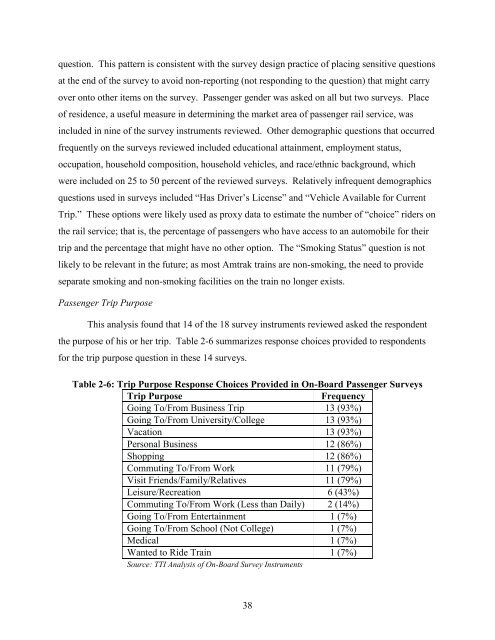Measuring the Benefits of Intercity Passenger Rail: A Study
Measuring the Benefits of Intercity Passenger Rail: A Study
Measuring the Benefits of Intercity Passenger Rail: A Study
Create successful ePaper yourself
Turn your PDF publications into a flip-book with our unique Google optimized e-Paper software.
question. This pattern is consistent with <strong>the</strong> survey design practice <strong>of</strong> placing sensitive questions<br />
at <strong>the</strong> end <strong>of</strong> <strong>the</strong> survey to avoid non-reporting (not responding to <strong>the</strong> question) that might carry<br />
over onto o<strong>the</strong>r items on <strong>the</strong> survey. <strong>Passenger</strong> gender was asked on all but two surveys. Place<br />
<strong>of</strong> residence, a useful measure in determining <strong>the</strong> market area <strong>of</strong> passenger rail service, was<br />
included in nine <strong>of</strong> <strong>the</strong> survey instruments reviewed. O<strong>the</strong>r demographic questions that occurred<br />
frequently on <strong>the</strong> surveys reviewed included educational attainment, employment status,<br />
occupation, household composition, household vehicles, and race/ethnic background, which<br />
were included on 25 to 50 percent <strong>of</strong> <strong>the</strong> reviewed surveys. Relatively infrequent demographics<br />
questions used in surveys included “Has Driver’s License” and “Vehicle Available for Current<br />
Trip.” These options were likely used as proxy data to estimate <strong>the</strong> number <strong>of</strong> “choice” riders on<br />
<strong>the</strong> rail service; that is, <strong>the</strong> percentage <strong>of</strong> passengers who have access to an automobile for <strong>the</strong>ir<br />
trip and <strong>the</strong> percentage that might have no o<strong>the</strong>r option. The “Smoking Status” question is not<br />
likely to be relevant in <strong>the</strong> future; as most Amtrak trains are non-smoking, <strong>the</strong> need to provide<br />
separate smoking and non-smoking facilities on <strong>the</strong> train no longer exists.<br />
<strong>Passenger</strong> Trip Purpose<br />
This analysis found that 14 <strong>of</strong> <strong>the</strong> 18 survey instruments reviewed asked <strong>the</strong> respondent<br />
<strong>the</strong> purpose <strong>of</strong> his or her trip. Table 2-6 summarizes response choices provided to respondents<br />
for <strong>the</strong> trip purpose question in <strong>the</strong>se 14 surveys.<br />
Table 2-6: Trip Purpose Response Choices Provided in On-Board <strong>Passenger</strong> Surveys<br />
Trip Purpose Frequency<br />
Going To/From Business Trip 13 (93%)<br />
Going To/From University/College 13 (93%)<br />
Vacation 13 (93%)<br />
Personal Business 12 (86%)<br />
Shopping 12 (86%)<br />
Commuting To/From Work 11 (79%)<br />
Visit Friends/Family/Relatives 11 (79%)<br />
Leisure/Recreation 6 (43%)<br />
Commuting To/From Work (Less than Daily) 2 (14%)<br />
Going To/From Entertainment 1 (7%)<br />
Going To/From School (Not College) 1 (7%)<br />
Medical 1 (7%)<br />
Wanted to Ride Train 1 (7%)<br />
Source: TTI Analysis <strong>of</strong> On-Board Survey Instruments<br />
38
















